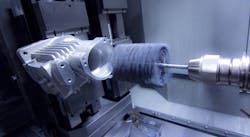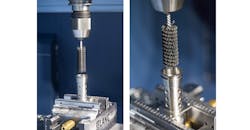Integrating Honing to Machining Brings Flexibility and Efficiency
Janos Garaczi is the owner and president of an award-winning machine shop but he continues to oversee the manufacturing operations, to ensure that everything is working as it should. Delta Machine Co. LLC, Huntington Beach, Calif., specializes in complex, tight-tolerance parts made of titanium, nickel alloys, stainless steel, aluminum, plastics and other uncommon alloys.
Garaczi is an uncommon character too, having started with the company as a machinist and now having worked his way to the top job. He takes seriously the responsibility for much of Delta Machine’s programming work, set-ups, and purchasing.
In the past decade, the shop has relied on a flexible, honing tool for a wide range of automated CNC machining applications such as cross-hole deburring, cylindrical honing, surface finishing, edge-blending and cleaning. By integrating flexible hones to the machining process, complex parts with cross-drilled holes and other difficult-to-access features can be deburred, honed, surface finished, etc. in-house, at less cost.
In automated machining, removing burrs and sharp edges in cross-drilled holes and other difficult-to-access areas -- such as undercuts, grooves, slots, or internal holes -- can be tedious and time consuming. One particular challenge is deburring the intersection of cross-drilled holes frequently found in engine and transmission components.
Despite the challenges, removing burrs from the production process is an absolute must for high-quality, precision parts. In many applications, cross-drilled holes act as conduits for fluids, lubricants and gases. Failing to remove burrs can block these critical passages or create turbulence in the flow. Burrs also can lead to part misalignments, affect dimensional tolerances, and limit the overall efficiency of machined components.
“Eliminating burrs is critical because if any loose material gets dislodged during use, there can be serious consequences,” Garaczi explained.
According to Garaczi, the tool he chose for such applications is the Flex-Hone from Los Angeles-based Brush Research Manufacturing (BRM). Characterized by the small, abrasive globules that are permanently mounted to flexible filaments, the product is a flexible, low-cost tool for sophisticated cross-hole deburring, honing, surfacing, and edge-blending. The hones are available in various abrasive types, sizes, and grit selections.“For de-burring holes and honing, when we need to clean up a component, it is the easiest tool to use for us. There is a large variety of grades and sizes and it is very versatile,” Garaczi said. Flexible hones are ideal in those applications because the tools are a cost-effective solution for smoothing edges and producing a blended radius for cross-hole deburring.
“In terms of accessibility, I haven’t found any other tools that can do what a Flex-Hone can, whether for multiple cross-holes or internal grooves,” the shop-owner continued. “There is really no way to effectively reach those areas with any other sort of tool.”
He added, “Right now, we are making more and more complex parts, especially when it comes to housings with ports all over the part. That is where the hone comes in really handy – for de-burring the holes where you drill into it.”
For best results, the deburring tool typically is rotated into the main bore into which the cross-holes break. After a few clockwise strokes, the tool is removed and the spindle reversed to rotate the flexible hone for a few more strokes in a counterclockwise direction. The forward and reverse rotation creates a symmetrical deburring pattern. Coolant should be used to keep metal cuttings and deburred metal in suspension.
According to Garaczi, removing burrs can be particularly problematic when dealing with machined superalloys, such as titanium, Monel, Inconel, Incoloy, Invar, Rene and Hasteloy, which are some of the most difficult materials to machine.
“The burrs are one of the biggest problems, particularly when machining superalloys,” Garaczi added. “Even during ‘grooving,’ if you cut the material from one side it just pushes the burr to the edge; and if you approach it from the other side it just pushes it back. It doesn’t want to break off the material cleanly. As soon as the tool gets a bit dull it gets a lot worse. So, sharp tools with the right geometry are the key.”
Garaczi noted that the Flex-Hone is available with a premium nickel-coated diamond abrasive for use on materials like carbide, ceramic, and aerospace steel alloys; as well as a CBN (cubic boron-nitride) option that is even harder and is specifically designed for superalloys, which can exhibit of high ductility and work hardening that produces “gummy machining” behavior if the correct abrasive tool is not applied.
According to Garaczi, when deburring superalloys such as titanium or 13-8 stainless, the Flex-Hone has been very helpful. “Most of the 13-8 we machine is heat-treated, so it is subject to significant burrs. The hone is ideal for removing even the most stubborn burrs,” he said.
Garaczi pointed out that he is installing the flexible hones into CNC equipment to automate the process and reduce the time required to finish superalloys and stainless steels.
Despite the fact that these hones are abrasive tools, Garaczi said that a distinction must be made between “abrasives” used for aggressive material removal and abrasive finishing tools. Finishing tools release little to no abrasive grit during use, and the amount generated is comparable to the metal chips, grinding dust, and tool abrasion created during the primary machining process.
Even if minimal fine solids are produced, the filtration requirements for abrasive tools are not much different than for machining. Any particulate can be removed easily using inexpensive bag or cartridge filtration systems.
“When you use the Flex-Hone for deburring, all you are doing is removing the burr. It doesn’t create much dust,” according to Garaczi. “So, for me, any grit or dust released is zero concern. It is not like we are grinding inside the machine with powder everywhere – this is not the same at all.”
For emphasis, he added: “These are very expensive, very accurate machines. I wouldn’t do anything to jeopardize the accuracy or lifespan of the equipment.”
He said that when making purchasing decisions for tools, a choice often is determined on a project-by-project basis. However, if the tool can reduce cycle times versus its cost, the decision is an easy one.
“There are definitely scenarios where it would be good to be able to perform surface finishing of this type of material on CNCs,” said Garaczi. “It would really save a lot of time and extra processing cost.”
Using the Flex-Hone is even helping Delta Machine cope with the unexpected demands of operating during the Covid-19 pandemic, because it can assist in accommodating more automated work being done. This not only means less labor is necessary, but that any workers on the shop floor can maintain the social distancing regulations required of them. “I want to do everything on the CNC machines whenever I can, especially now,” Garaczi said.
To achieve this, Delta Machine outfits its tool carousels with various sizes of Flex-Hones. “For a part, we might use two to three different size hones, depending on the number of cross port intersections and different hole sizes,” said Garaczi. “However, it is really easy to put a Flex-Hone in a toolholder, give it a simple toolpath cycle, and let it run.”
In particular, automating cross-hole deburring a lot of offline work, he noted, since Delta Machine’s parts usually are complex designs with many intersecting holes.
“It is difficult for a person to repeat such work reliably, to the required standard of quality. Automating this with the CNC machine usually will produce more consistent results, while enabling greater social distancing among our staff on the production floor,” concluded Garaczi.
Del Williams is a technical writer in Torrance, California.
About the Author
Del Williams
Del Williams is a technical writer based in Torrance, Calif. He writes about health, business, technology, and educational issues, and he holds an M.A. in English from C.S.U. Dominguez Hills.

